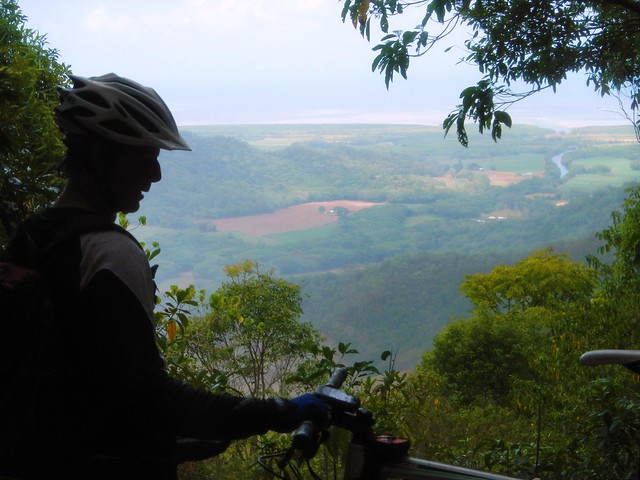
We were staying at Palm Cove between Cairns and Port Douglas to watch the Total Solar Eclipse, which provided an ideal opportunity to explore the spectacular rainforest inland from the coast.
Being an adventurous soul, I thought I’d just hop on the bike and follow my GPS, but I’ve learned to listen to the wisdom of my wonderful wife who insisted I ride with someone who actually knew the area. That was how I met Dan Foley from Dans Mountain Biking. Dan has been mountain biking in Far North Queensland for over twenty years and knows the trails intimately. He operates guided tours by mountain bike through places like Cape Tribulation, Daintree National Park, Bloomfield Track, Atherton Tablelands and Mulgrave Valley. Today he took me through Mulgrave National Park and “The Bump Track”. The rainforest is full of things that eat, sting, bite, slice, and/or kill you, so I’m really glad Dan was there to keep me out of harms way.
Funnily enough, while thinking of all the things that could chew me up, we started our ride from the car park at Hartleys Crocodile Farm at Wangetti.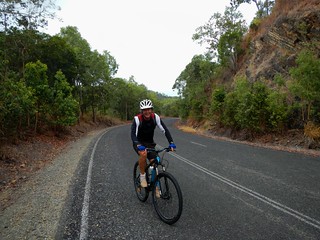

The first part of the ride was up Quaid Road – a disused development road which, over the space of 5km, climbs 500m up from Wangetti on the coast into the rainforest. It was built by property developer George Quaid in the 1980′s just before the area was declared a wet tropics world heritage area. So (thankfully) George didn’t get to carve up the rainforest. The road is gated off – so motor vehicles can’t use it. But it’s a really easy way to get from the coast into the mountains by mountain bike.
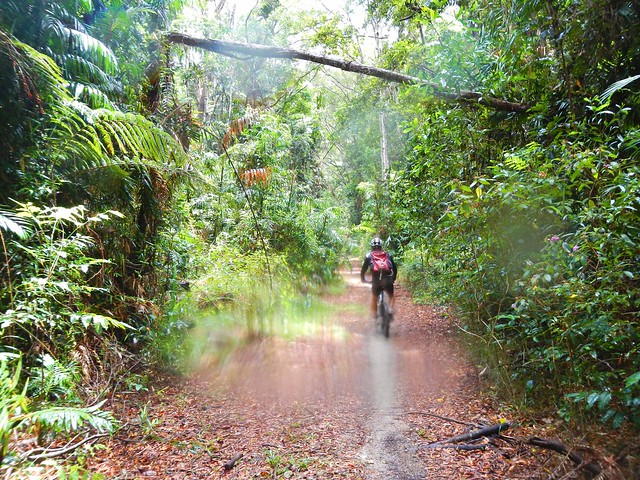
Once we got into the rainforest (emphasis on “rain”) it started raining. Dan took me along the “twin bridges” track – one of the many management trails in the area.

Not far in, we encountered what I thought was a dead snake. “How sad” I thought as I sidled up close to it to take a picture. Dan suggested we give it a wide berth in case it was still alive. I listed to him, and once past it, we poked it gently with a stick. To my great delight the Red Bellied Black Snake (Pseudechis porphyriacus) reared up at us. It was a alive! And so was I for listening to Dan. Those snakes are venomous and can give you a nasty bite.

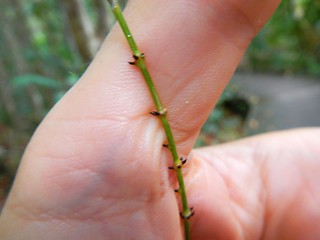
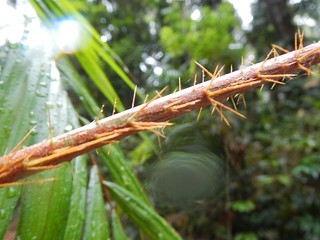
A little further along the track, and Dan stopped me again. This time it was for a Wait-A-While or Lawyer Cane (Calamus australis). This is a species of climbing Palm Tree. It drops long thin spike-covered tendrils down to the forest floor below. They’re tough and sharp. If you ran into one (or tried to ride past one on a bike), the sharp tendrils could inflict horrible damage. Dan told me stories of motor cyclists losing limbs to the plant while speeding through the forest on a trail bike. The dangerous thing is that the tendrils are so thin that they’re nearly impossible to see. And with the rain pouring down, and glasses fogged up, it would have been really easy for me to get snagged on one (or two, or three). Thankfully (for me), Dan rode in front. He hit the vines first. I just made sure I took notice when he pointed them out to me.
Aborigines used the mature cane from the vine as struts to build shelters. They wove the spiky tendrils into snares and fish traps. And by cutting the thick canes they were able to collect drinking water when needed. A one meter long section of the vine, when cut, could supply over a cup of drinkable water.
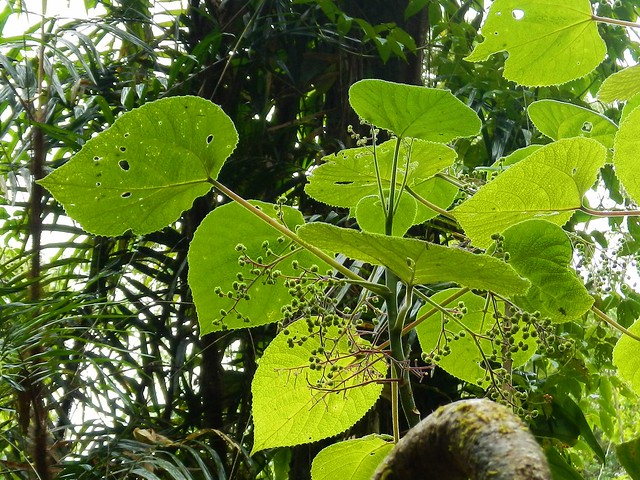
Another nasty surprise in this part of the world is the Gympie Gympie or Stinging Tree (Dendrocnide moroides) – a highly toxic plant that can inflict severe pain at the slightest touch. The cure is duct tape or leg wax applied to the affected area of skin to pull the thin spikes out. The worst thing you can do is rub the area or apply water to it.
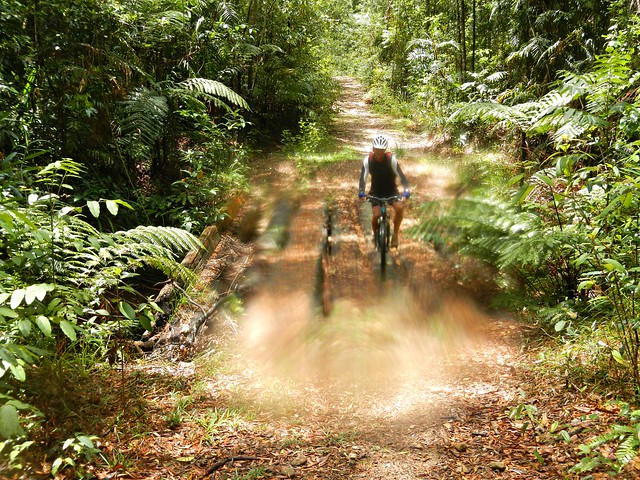
We slowly continued our ride northwards over several log bridges which crossed quiet creeks. The water is crystal clear and is good to drink as well. The trick with log bridges is to make sure you don’t get your wheel stuck in the gap between the logs, so it’s important to “Pick a plank” and stick to it, or run the risk of flying over the handlebars ![]()


The “Twin Bridges” track is named after two large log bridges which used to span Spring Creek. Floodwaters destroyed the bridges a while ago, and all that is left is a large pile of logs. So we had to wade across the creek in thigh deep water. Thankfully there were no crocodiles ![]()
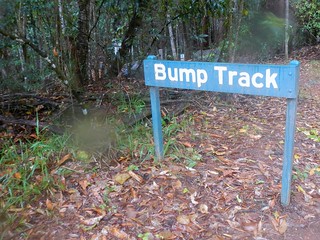
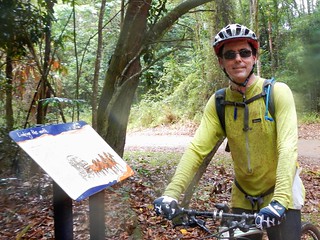
Eventually we reached the top of “The Bump Track”. This track is part of the Bicentennial National Trail and forms part of the route that Cobb & Co took between Port Douglas and Georgetown in the 1880′s. The 322km trip trip used to take five days. When the coach got to the Bump Track, all the passengers had to get out and walk, while the horses dragged the stage coach up the steep hill.
Today we were going DOWN the Bump Track, not up it. At its steepest, the track drops over 300 metres in 1.8 km. My brakes were totally cooked by the time we got to the bottom. So I was glad to stop halfway down to enjoy the view of the Mowbray River to the east, and let the brakes cool down.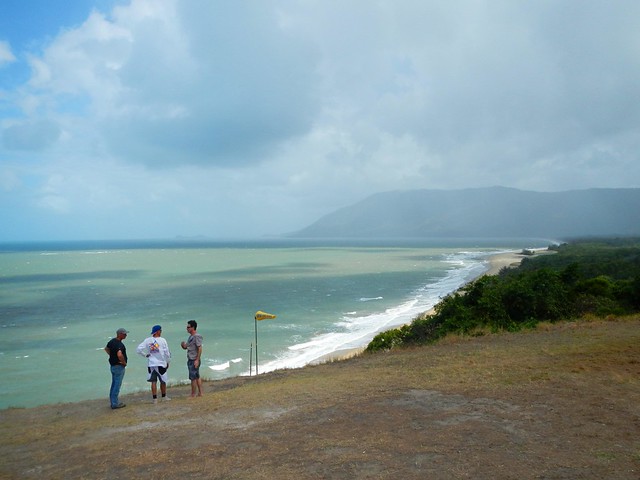
Once at the bottom, we made our way back to the Captain Cook Highway near Port Douglas and made our way south along the bitumen. This must be one of the most scenic highways in the country. On the way back we stopped at Rex Lookout to enjoy an amazing panorama of the coastline to the south.
All up we rode 55km in just over 5 hours including breaks. I burned 5,000 kcal as we ascended a total of 1,250m. On the tough-o-meter I’d rate this ride about 7.5 out of 10 for difficulty, but 10 out of 10 for fun and stunning views.
If you’re new to the area, DON’T do this ride by yourself. Get someone who knows the area, like Dan Foley. When you’re taking on a tropical rainforest with “Wait-A-While” vines, Gympie Gympie plants, Black Snakes, Crocodiles, and log bridges with treacherous gaps, a competent guide will ensure that you arrive home happy and in one piece.

No comments:
Post a Comment